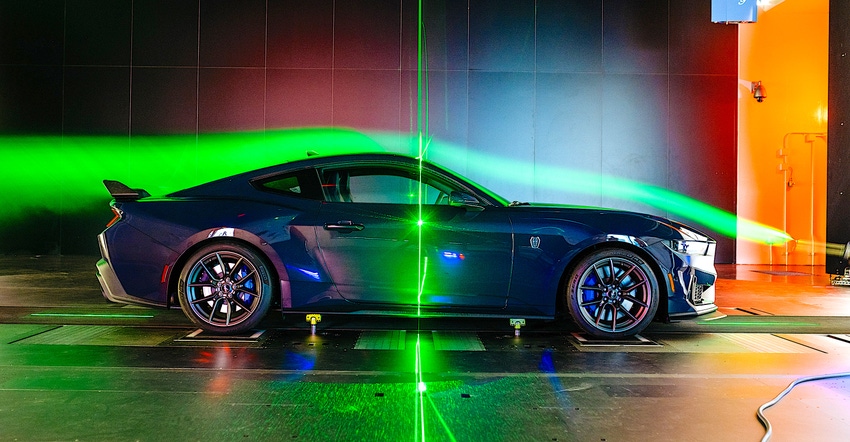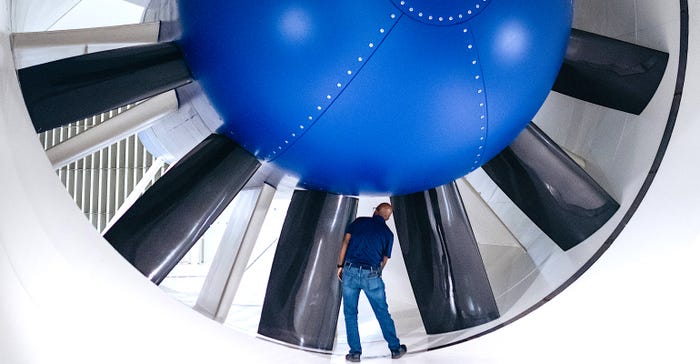Ford’s New 200-MPH, $200-Million Wind Tunnel
This rolling road tunnel is the world’s fastest, just in time for Ford’s 2026 foray into Formula 1.

Aerodynamic drag is a key factor in the efficiency of electric vehicles and the performance capability of sports cars and race cars, so Ford has invested in this capability with a new rolling road wind tunnel in Allen Park, Mich.
The new wind tunnel’s price tag was reported by Motor Trend to be $200 million, topping the $124 million of Honda’s similar new wind tunnel we showcased previously.
Another superlative related to “200” is the tunnel’s top speed of 200 mph, which slightly exceeds that of the Honda tunnel, according to Ford North American Wind Tunnels Supervisor, John Toth. Ford’s previous tunnel dates to the late ‘90s.
Rolling Road
The moving surface of a rolling road wind tunnel is like a giant conveyor belt that the test car rolls on. This is important because a stationary surface interferes with the flow of air past the underside of the car. A rolling road gives more accurate data in terms of both wind drag and downforce
Ford’s new tunnel has two arrangements. One has five belts, so each wheel gets its own belt, and a larger belt runs beneath the center of the car. The other is a single large belt, and this is the one that can run at speeds as fast as 200 mph.

Aerodynamic Frenemies
One thing that the Ford tunnel does not do, that the new Honda tunnel does, is testing for wind noise. The sound insulation needed for aeroacoustics testing compromises tunnels’ ability to do high-speed testing, and that was Ford’s focus for this facility, Toth said. “We optimized the facility to do one thing and do it very well,” he observed.
Instead of acoustic insulation, Ford lined its tunnel with epoxy to smooth the flow of air, increasing speed and reducing energy consumption. The tunnel’s maximum power is 5.3 megawatts, and it needs a 2 MW chiller when running at that level. But sweating details like the epoxy coating have made the tunnel more efficient than predicted. Expectations were that it would need 4.2 to 4.3 MW to sustain 200 mph wind, but in practice, the tunnel can do that at just 3.2 MW, according to Toth.
Power for the tunnel comes from the public utility grid, through Ford’s own industrial 70-MW substation with high-tension transmission lines to the facility. Tapping into the 120,000-volt grid with its substation then sending 13,200-volt power on the high-tension lines lets the tunnel run at high efficiency, Toth explained.
Honda Opens “World’s Most Advanced” Wind Tunnel
His goal had been to employ grid batteries too, but that didn’t work out. “We tried,” Toth recalled. “It was far more expensive than I expected. I was unpleasantly surprised because that was one of the things we wanted.”
The Ford and Honda wind tunnels were both designed by Jacobs Engineering, and the similarities between them meant the two teams could compare notes as they worked to get their facilities ready to use.
“We talk about our challenges,” Toth explained. “We help each other out.”
This is Ford’s first rolling road tunnel, so the company has been learning new aspects relating to that. “When you bring up a brand new facility there are tons of challenges,” Toth said. “When it is your first (rolling road tunnel), there are additional challenges.”

Toth’s team went through the slow, methodical process to sort everything out getting the tunnel ready, he said. “There are literally 10,000 things that have to go right for the facility to run and only one thing to go wrong to shut it down.”
Startup Headaches
The tunnel’s start-up commissioning process took six and a half months, with the facility running 20 hours a day, seven days a week, as the engineers sought to calibrate it. Before the team can measure the drag of objects in the tunnel, they must first establish a baseline of zero with an empty tunnel.
“You are literally trying to measure zero,” said Toth. “It is really hard to do. I mean really hard to do.”
A unique component of Ford’s tunnel is the presence of two flow traverses instead of the usual single one. This is the post that holds 40-percent scale models in position in the tunnel, and in this case, there are two of them. One is light blue and one is dark blue and they’ve been dubbed “Henry” and “Clara,” after the company’s founder and his wife.
They carry pressure probes and components for particle image velocimetry for flow visualization. Henry and Clara move in all three axes with 1mm accuracy and can move in synchronization, which could be used to model a pass of one drafting Nascar stock car on another, for example.
For full-size vehicles on the rolling road, there is a 40-foot-diameter turntable that rotates 30 degrees in one-degree increments to test the car in various yaw conditions or in crosswinds.
Until this tunnel opened, Ford had to use the Windshear tunnel in Concord, N.C. for rolling road tests. Ford’s new tunnel is a generation newer than that facility and benefits from a change in how it controls boundary layer growth.
Windshear’s tunnel strips off the boundary layer air at the nozzle and vents it outside the test cell, but Ford’s tunnel returns it somewhere else in the airstream. “This helps keep your static pressure differential flat,” explained Toth. “The flatter that can be, the better.”
Such details, along with the 200-mph top speed and the dual flow traverses give the Ford tunnel a solid claim on the title of “most advanced.” But of course, there are others under construction that will surely raise the bar.
About the Author(s)
You May Also Like





